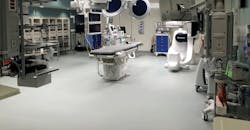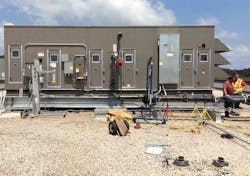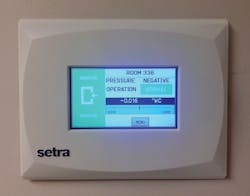Ventilation Strategies for Healthcare Facilities
By GREGORY HUDSON, P.E., MBA
RMF Engineering, Inc.
Charleston, SC
When thinking about improving the energy efficiency of buildings, hospitals are a critical pain point because of their energy consumption and the parameters around any adjustments to the ventilation system. When reducing overall energy usage, proper ventilation and indoor air quality (IAQ) must be maintained to ensure proper infection control and patient safety.
Hospitals consume significantly more energy than buildings and facilities of similar size. The large quantity of outside air necessary for proper ventilation requires an increased amount of energy to condition.
It is key to note that both the Facilities Guidelines Institute (FGI) and ASHRAE have specific requirements for various healthcare program spaces detailing total air changes, outside air changes and the need to fully exhaust certain spaces depending on the use. Tackling the challenge of energy efficiency in healthcare spaces requires an understanding of the FGI and ASHRAE requirements as they relate to available energy solutions.
Safety and Infection Control
Ventilation rates are defined in ASHRAE Standards 62.1 and 170. Administrative and circulation spaces within hospitals are ventilated in accordance with Standard 62.1, while spaces specific to hospitals such as patient rooms, imaging spaces and surgical suites are ventilated in accordance with Standard 170, which is also referenced by FGI. Standard 170 provides additional information in terms of minimum outdoor air changes and total air changes required for each type of space along with which spaces are required to be fully exhausted.
Appropriate ventilation rates are only effective if they are applied properly. Air device selection and placement, a clean source or outside air free of contaminants, removal of contaminants through proper filtration or direct exhaust and proper controls capable of maintaining appropriate airflows and pressure relationships ensure that ventilation rates defined in ASHRAE Standards are effective in preventing infection within the hospital environment and ensuring the safety of patients and the public.
| Check out this additional resource on ventilation optimization: New Research Calls for ‘Ventilation Optimization’ |
Healthcare facilities that may not be properly ventilated, designed or controlled can lead to the spread of airborne pathogens throughout the facility. Hospital patients who have compromised immune systems and are more susceptible to infection will likely be infected and can spread pathogens to the rest of the hospital.
Appropriate ventilation, when properly applied and designed, can limit the spread of airborne pathogens throughout a healthcare facility, but these higher ventilation rates come at an increased energy cost to the owner. Reduction of the energy cost is a goal for every owner, but any energy reduction cannot compromise patient safety.
Energy Recovery and Ventilation Technologies
Installing and using high-quality filters is a good way to help reduce and eliminate contaminants from entering the building, and eliminate larger particles that would normally recirculate through the facility. Designers and engineers should reference Standards 62.1 and 170 for information on required filters. High-efficiency particulate air (HEPA) level filtration is required for some hospital applications such as surgical suites. HEPA filters are able to remove submicron particles, including some bacteria and viruses, from the airstream. Unfortunately, the better the filters are at removing particulates, the greater the pressure drops across them and therefore the more fan energy is required to move the required air volume through them.
Bipolar ionization is a relatively new technology in the United States, with the capability to break down microorganisms such as bacteria, viruses and mold as well as breaking down odors and volatile organic compounds (VOCs). The system utilizes one or more ionization tubes with a specially designed generator and control system. Bipolar ionization systems create negative and positive ions which then react with oxygen and water vapor within the air stream, creating free radicals. These free radicals in turn create chemical changes, which can damage viruses, bacteria and other microorganisms that often cause infections within a hospital. Even with this kind of system, filter media is still necessary to remove larger particles from the air stream.
Air-to-Air Heat Recovery
According to the ASHRAE HVAC Design Manual Guide for Hospitals and Clinics, reheat is “often the largest single energy-consuming process in large healthcare facilities.” One way to address this is through air-side heat recovery devices. These devices take energy from the exhaust air stream and move it to the outdoor airstream.
For hospital applications, energy recovery technologies need to isolate the two airstreams as much as possible to prevent cross-contamination. Crossover airflow can allow pathogens that were removed through an exhaust air system to be returned into the supply air stream. Typical energy recovery wheels are not a viable option due to the potential for crossover airflow. Devices such as heat pipes, coil loop systems or plate and frame heat exchangers keep the air streams separate to eliminate potential cross-contamination, but still provide energy movement from exhaust air to outside air.
These devices are sensible only so the overall efficiency is lower than an energy recovery wheel, but removing the potential for cross-contamination is critical for healthcare applications. In all cases, the additional energy required for these systems should be considered against the reduction in heating and cooling energy required to condition the outdoor airstream.
A heat pipe system is a closed system, utilizing a single coil that spans the two airstreams. The capacity of the heat pipe is modulated via bypass dampers or tilt control of the coil utilizing the phase change of the fluid within the coil as the motive to move the fluid from one side of the coil to the other. Some cross-flow is possible with this system, but proper sealing within the air handling unit will limit cross-contamination. Ventilation load reduction can be as high as 20 percent in moist climates and 50 percent in dry and cold climates. This amount of load reduction may not be high enough to warrant the increased fan power required to overcome the additional air pressure drop through the coil.
Coil loop systems are small systems utilizing a pump to move fluid between the coil in the exhaust airstream to the coil in the ventilation airstream. This allows for the two airstreams to be separated as opposed to being side by side or located within a central air handling system. Energy could be removed from a dedicated exhaust system and shifted to an air handling system. The reduction in ventilation load for moist climates can be as high as 20% and 55% in dry and colder climates. Depending on the climate, those load reductions may not be high enough to justify the additional costs in pumping and fan energy that is required.
The fixed-plate heat exchanger sometimes called a plate and frame heat exchanger, utilizes a cross-flow pattern of aluminum dimpled or channeled plates with face and bypass dampers to modulate the overall capacity. The overall size of a fixed plate heat exchanger for air handlers can be quite large and that additional size and weight need to be considered during the design process. Some cross-contamination is possible with the leakage across the plates, but this cross-flow is minimal. The reduction in ventilation load for moist climates can be as high as 30% and 70% in dry and colder climates. As with the other systems, the additional energy required to move air through the heat exchanger needs to be considered.
Controls and Conditions
There are strategies available through the use of digital controls that allow for energy efficiency such as unoccupied and nighttime setbacks, optimal start/stop programs and temperature resets based on outside air conditions that will not sacrifice patient safety or indoor air quality.
Unoccupied and nighttime setbacks are a relatively simple strategy to reduce energy. The basic strategy is to allow space conditions to change during times when spaces are not in use. During the winter months, unoccupied space temperatures could drop below normal occupied setpoints to save heating energy.
In the summer, the unoccupied space temperatures could rise above normal occupied space temperature conditions, saving on cooling energy. Both scenarios also save on fan energy because, as the unoccupied conditions are met, airflow could be reduced or cut off to the space. Implementing this strategy can be scheduled for unoccupied building times.
However, for most hospitals that operate continuously, occupancy sensors may be more effective. These can be integral to thermostat controls or lighting controls. Lighting controls are a relatively simple strategy: once the lighting control system turns the lights in the space off as the space has become unoccupied, the space conditions can go into an unoccupied setting through a building automation system. Once someone enters the space, causing the lights to turn on, the HVAC system will return to an occupied setting.
For spaces with a specific air change requirement, the space conditions can remain the same, but an unoccupied air change rate can be implemented to help reduce energy. Unoccupied settings need to be discussed with an owner and in the case of unoccupied air change rates, designers can have a study performed to determine what, if any, air change rate setbacks can be employed given the specific space.
ASHRAE Standard 90.1 provides information on optimal start/stop programs for HVAC systems. These allow for systems to shut down and restart in unoccupied scenarios, especially when areas will be unoccupied over a long period of time and will not be occupied until a new workday was to begin. The optimal start/stop program will then turn the system on at a specific time, based on historical data, to ensure that the occupied conditions are met by the time the area will be occupied again. Not operating a system during unoccupied periods and then starting and stopping the operation of the HVAC system at the optimal time helps to save energy by only operating the system when needed.
Another control strategy that can provide energy savings is a supply air temperature reset. This allows for the supply air temperature to increase above the normal setpoint as long as all the space temperature and humidity setpoints have been met. By increasing the supply air temperature when possible, cooling energy is saved and the load on the main cooling plant is reduced.
All of these strategies maintain indoor air quality and patient safety while reducing energy. This is accomplished by reducing heating and cooling loads while space conditions are maintained and during times at which spaces are not occupied.
##########
Based in Charleston, the author is an ASHRAE member and project manager at RMF Engineering, Inc., where he has worked since 2010. He holds a mechanical engineering degree from Clemson University and an MBA from the University of South Carolina.



